Top Rankings
West Las Vegas School District ranks among the top 20% of public school district in New Mexico for:
Category
Attribute
Community Size
Largest student body (number of students) (Top 1%)
For the 2025 school year, there is 1 public charter school serving 79 students in West Las Vegas School District. This district's average charter testing ranking is 5/10, which is in the bottom 50% of public charter schools in New Mexico.
Public Charter School in West Las Vegas School District have an average math proficiency score of 50% (versus the New Mexico public charter school average of 31%), and reading proficiency score of 20% (versus the 42% statewide average).
Minority enrollment is 80% of the student body (majority Hispanic), which is more than the New Mexico public charter school average of 73% (majority Hispanic).
Overview
This School District
This State (NM)
# Schools
10 Schools
100 Schools
# Students
1,567 Students
31,703 Students
# Teachers
108 Teachers
2,226 Teachers
Student : Teacher Ratio
15:1
15:1
District Rank
West Las Vegas School District, which is ranked within the bottom 50% of all 143 school districts in New Mexico (based off of combined math and reading proficiency testing data) for the 2021-2022 school year.
The school district's graduation rate of 70-74% has stayed relatively flat over five school years.
Overall District Rank
#123 out of 144 school districts
(Bottom 50%)
(Bottom 50%)
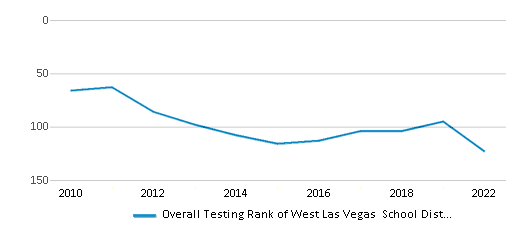
Math Test Scores (% Proficient)
11%
24%

Reading/Language Arts Test Scores (% Proficient)
28%
34%
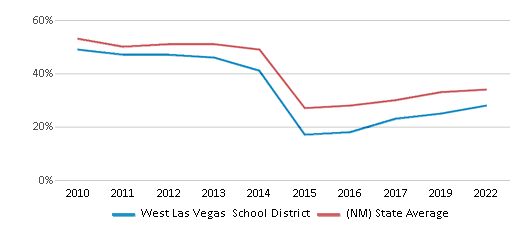
Science Test Scores (% Proficient)
23%
33%
Graduation Rate
(20-21)70-74%
66%
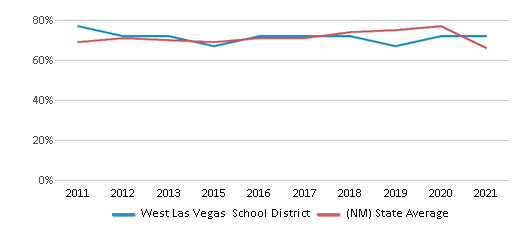
Students by Ethnicity:
Diversity Score
0.18
0.56
# American Indian Students
14 Students
1,768 Students
% American Indian Students
1%
6%
# Asian Students
10 Students
522 Students
% Asian Students
1%
2%
# Hispanic Students
1,417 Students
19,284 Students
% Hispanic Students
91%
61%
# Black Students
6 Students
707 Students
% Black Students
n/a
2%
# White Students
116 Students
8,713 Students
% White Students
7%
27%
# Hawaiian Students
n/a
57 Students
% Hawaiian Students
n/a
n/a
# Two or more races Students
4 Students
652 Students
% of Two or more races Students
n/a
2%
Students by Grade:
# Students in PK Grade:
50
410
# Students in K Grade:
119
1,646
# Students in 1st Grade:
119
1,711
# Students in 2nd Grade:
114
1,818
# Students in 3rd Grade:
125
1,672
# Students in 4th Grade:
109
1,716
# Students in 5th Grade:
133
1,816
# Students in 6th Grade:
145
2,745
# Students in 7th Grade:
97
3,117
# Students in 8th Grade:
115
3,066
# Students in 9th Grade:
135
3,365
# Students in 10th Grade:
115
3,220
# Students in 11th Grade:
121
2,963
# Students in 12th Grade:
70
2,438
# Ungraded Students:
-
-
District Revenue and Spending
The revenue/student of $16,151 is higher than the state median of $14,756. The school district revenue/student has stayed relatively flat over four school years.
The school district's spending/student of $16,140 is higher than the state median of $14,121. The school district spending/student has stayed relatively flat over four school years.
Total Revenue
$25 MM
$4,694 MM
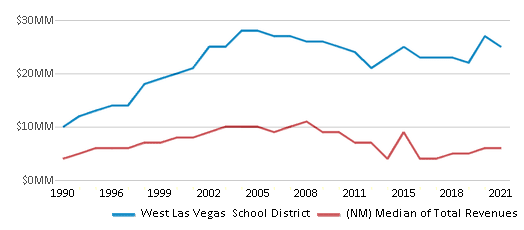
Spending
$25 MM
$4,492 MM
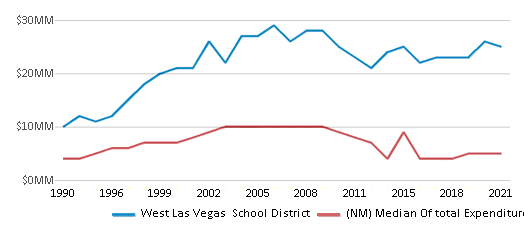
Revenue / Student
$16,151
$14,756
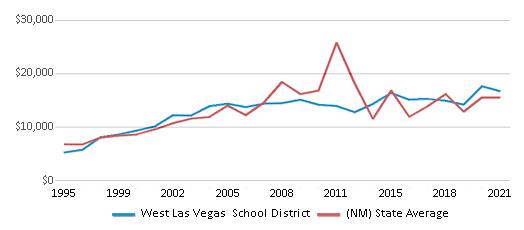
Spending / Student
$16,140
$14,121
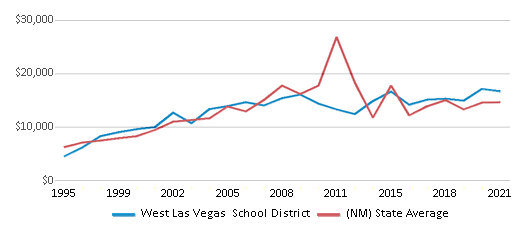
Best West Las Vegas School District Public Charter Schools (2025)
School
(Math and Reading Proficiency)
(Math and Reading Proficiency)
Location
Grades
Students
Rank: #11.
Rio Gallinas School
Charter School
(Math: <50% | Reading: ≤20%)
Rank:
Rank:
6/
Top 50%10
2730 Romero St
Las Vegas, NM 87701
(505) 426-2311
Las Vegas, NM 87701
(505) 426-2311
Grades: K-8
| 79 students
Recent Articles

Year-Round Or Traditional Schedule?
Which is more appropriate for your child? A year-round attendance schedule or traditional schedule? We look at the pros and cons.

Why You Should Encourage Your Child to Join a Sports Team
Participating in team sports has a great many benefits for children, there is no doubt. In this article you will learn what those benefits are.

White Students are Now the Minority in U.S. Public Schools
Increasing birth rates among immigrant families from Asia and Central and South America, combined with lower birth rates among white families, means that for the first time in history, public school students in the United States are majority-minority. This shift in demographics poses difficulties for schools as they work to accommodate children of varying language abilities and socio-economic backgrounds.





